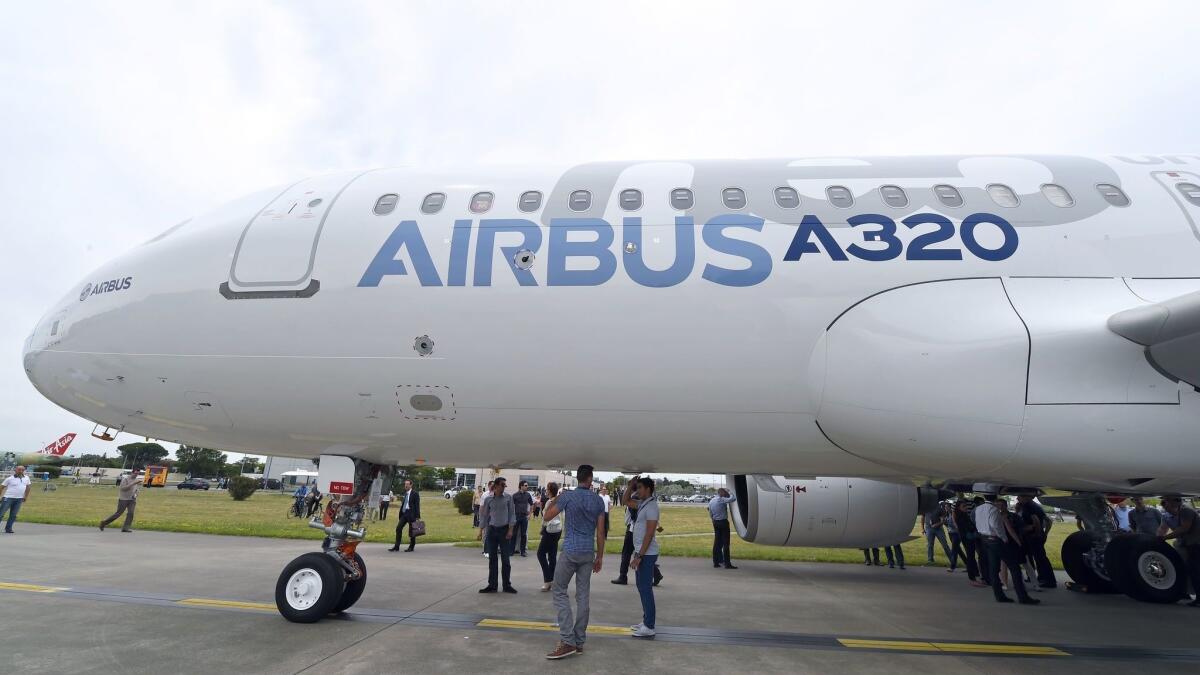Airbus considers making the next version of its top-selling jet an electric hybrid

- Share via
Airbus is considering bringing the world’s first hybrid-electric airliner to market as it weighs its strategy for replacing the bread-and-butter A320neo narrow-body jet in the next 15 years. That would mark a technological leap for the aerospace industry.
The European planemaker has grown confident that the revolutionary propulsion system will be ready for rollout on an all-new single-aisle jet around 2035, according to people with knowledge of its planning. Although the company has been public about its interest in hybrid engines, Airbus is now willing to consider powering its most important aircraft with the technology, said the people, who asked not to be named discussing internal deliberations.
Timelines aren’t certain and will shift as different capabilities evolve, the people said, adding that Airbus would start with a smaller single-aisle and work its way up to a size comparable to the A321neo, which seats as many 240 people.
Here’s why there are no electric commercial jets -- yet »
Airbus is still pursuing a conventional replacement for its A320 family, which started service in the late 1980s to compete against Boeing’s then-market leading 737. It is studying using redesigned wings, more composite materials, and tweaks to current engine architectures to get to the 20% boost to fuel efficiency that is needed to justify an all-new aircraft.
In a conventional jet airplane, the engine sucks air in through its front, a compressor squeezes it, and fuel is sprayed in and lit, creating burning gases and forward thrust. With an electric-powered plane, batteries power a motor that spins a propeller. That generates far less thrust, which is why electric planes tend to be slow.
One design for a hybrid fuel/electric jet is to use a conventional engine mounted at the back of the plane to charge a battery, in addition to producing its own thrust. That would enable electric propulsion on each wing, augmenting power during takeoff and landing — by far the most fuel-guzzling parts of a flight. The aircraft would operate at slightly lower speeds, adding, for example, about 30 minutes to a typical flight within Europe.
The launch of a hybrid model, while the biggest advance in the commercial aviation industry for decades, would bring its own challenges — not least convincing airlines to back technology that might initially offer only limited range and capacity.
Airbus is confident that airlines would be prepared to wait for the step-change in efficiency that a hybrid would provide, according to the people familiar with its planning. An upswell in development of hybrid and battery-electric aircraft coincides with rising consumer awareness of the carbon-dioxide effect of jet emissions. The Environmental Protection Agency estimates that transportation is the biggest contributor to U.S. greenhouse-gas emissions, with aircraft contributing 9% of the transportation total. (Airbus has targeted reducing CO2 emissions by 75% by 2050.)
Airbus’ decision will in part come down to whether rival Boeing Co. decides to accelerate its own clean-sheet narrow-body design in the wake of the 737 Max crisis that has seen that aircraft grounded since March, they said.
More to Read
Inside the business of entertainment
The Wide Shot brings you news, analysis and insights on everything from streaming wars to production — and what it all means for the future.
You may occasionally receive promotional content from the Los Angeles Times.









